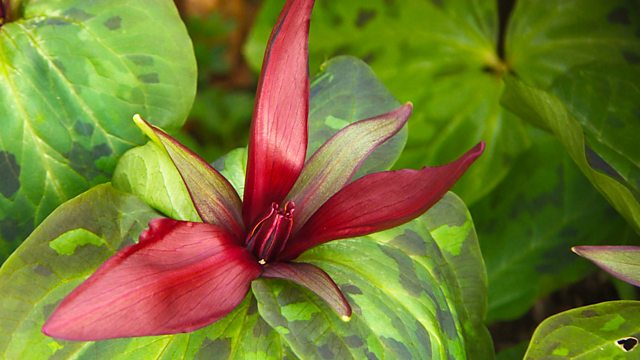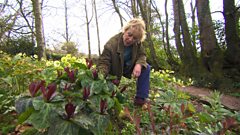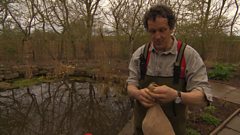
Episode 8
Gardening magazine. Monty Don makes a start on turning his vegetable patch into a cottage garden, and Carol Klein is at Glebe Cottage, Devon, to reveal the history of the trillium.
Monty Don makes a start on turning his vegetable patch into a cottage garden. He also tackles the blanketweed that has taken over his pond, and plants a grapevine to train through a hole in the wall of his new greenhouse.
Meanwhile, Carol Klein is at Glebe Cottage in Devon where she reveals a little of the fascinating history of one of our woodland gems, the trillium.
And Joe Swift travels to Swansea to explore a wonderful suburban garden with a charm all of its own.
Last on
Clips
-
![]()
Trillium propagation
Duration: 02:12
-
![]()
Tackling pond algae
Duration: 03:41
Dessert grapes

If you live south of a line drawn from The Wash to Pembroke, there’s a good chance you’ll be able to grow a decent crop of dessert grapes outside. YourÌý chances of success will be greatly increased if you grow them against a warm, sunny wall. North of this line, it’s best to grow them under glass. The variety you choose will make a big difference too. Here are our top 10 recommendations, including some dual-purpose varieties that could be used to make wine as well.
Ìý
Varieties to grow outdoors in the South or in an unheated greenhouse in the North:Ìý
- Boskoop Glory
- Himrod
- Lakemont
- Phoenix (dual-purpose)
- Regent (dual-purpose)
- Siegerrebe (dual-purpose)
Varieties to grow in an unheated greenhouse in the South or one that is heated in the North:
- Black Hamburgh
- Chasselas
- Muscat of Alexandria
- Muscat Hamburg
Ìý
Ìý(www.rhs.org.uk)
Garden featured
Tony Ridler’s Garden
7 St Peter’s Terrace
Cockett
Swansea
SA2 0FW
Ìý
The amazing topiary garden Joe Swift went to see in Swansea is open by appointment through April, May and June. It is also open for the National Gardens Scheme on Sunday 28 April, Sunday 19 May and Sunday 16 June between 2-5pm. For more information, please see below.
Ìý
Ìý(www.ngs.org.uk)
Barley straw
Scientific research has shown that as barley straw rots down in water, it can inhibit the growth of algae. It is thought that some sort of natural agent is released as it decomposes. To be effective, there are several things you need to know.
Ìý
1. Barley straw can be applied at any time of year, but will be more effective if it is applied in early spring.
Ìý
2. Mesh bags or a pair of nylon tights are a good way of containing the straw. The straw needs to be loosely packed so that the water can pass freely through it.
Ìý
3. It rots down faster in summer than winter, but as a rule remains active for between 4 and 6 months.
Ìý
4. Further doses will be required to keep the algae at bay, but don’t wait until the straw has completely rotted down before the adding the next lot. This is because it takes time for the new straw to become active.
Ìý
5. The amount you add will depend on the surface area of your pond rather than its volume. Aim for 50g a sq m (2oz a sq yd) for your initial dose. Thereafter, it can be reduced to 25g a sq m (1oz a sq yd).
Ìý
6. It takes time to work, so be patient!
Ìý
Garden centres sell packs of barley straw specifically for this purpose, but you could also try your local pet shop. This is often a cheaper way of buying it - the bag of straw Monty used only cost £1.20, for example.
Ìý
Ìý(www.ceh.ac.uk)
Jobs for the weekend: Sow carrots
Now the soil is starting to warm up, it’s time to sow carrots. They must be sown direct, preferably in soil that has not been freshly manured. Either sow them in a line or broadcast them across the surface, making sure you don’t sow too thickly. Give them a light rake along with a quick water and that’s it!
Ìý
Ìý(www.rhs.org.uk)
Jobs for the weekend: Pinch out sweet peas
Sweet peas are easy to raise from seed and, within a matter of months, will fill a summer border with deliciously scented, colourful blooms. But if your pot-grown seedlings are looking a bit straggly at the moment, don’t despair! Simply nip out the growing tips and they’ll soon recover. And what’s more, you’ll end up with nice bushy plants and more flowers for your money.
Ìý
Jobs for the weekend: Take dahlia cuttings
If you have a favourite dahlia you’d like more of, then now’s the time to takeÌý cuttings. When the shoots are about 7.5cm (3in) long, cut them below the surface of the compost with a sharp knife and remove the lower leaves. Insert around the edge of a small pot filled with a 50:50 mix of compost and perlite. Give them a drink, place a clear plastic bag over them and keep somewhere warm. With luck, they will root within a matter of weeks.
Ìý
Credits
| Role | Contributor |
|---|---|
| Presenter | Monty Don |
| Presenter | Carol Klein |
| Series Editor | Liz Rumbold |
| Producer | Babs Lewis |
| Presenter | Joe Swift |
Broadcasts
- Fri 26 Apr 2013 20:30
- Sun 28 Apr 2013 08:15


